Kullanıcı:Sp1dey/Çalışma
Energy
[değiştir | kaynağı değiştir]
Egypt has a developed energy market based on coal, oil, natural gas, and hydro power. Substantial coal deposits in the northeast Sinai are mined at the rate of about 600.000 ton (590.000 emperyal ton; 660.000 küçük ton) per year. Oil and gas are produced in the western desert regions, the Gulf of Suez, and the Nile Delta. Egypt has huge reserves of gas, estimated at 2.180 kilometreküp (520 cu mi),[1] and LNG up to 2012 exported to many countries. In 2013, the Egyptian General Petroleum Co (EGPC) said the country will cut exports of natural gas and tell major industries to slow output this summer to avoid an energy crisis and stave off political unrest, Reuters has reported. Egypt is counting on top liquid natural gas (LNG) exporter Qatar to obtain additional gas volumes in summer, while encouraging factories to plan their annual maintenance for those months of peak demand, said EGPC chairman, Tarek El Barkatawy. Egypt produces its own energy, but has been a net oil importer since 2008 and is rapidly becoming a net importer of natural gas.[2]
Egypt produced 691,000 bbl/d of oil and 2,141.05 Tcf of natural gas in 2013, making the country the largest non-OPEC producer of oil and the second-largest dry natural gas producer in Africa. In 2013, Egypt was the largest consumer of oil and natural gas in Africa, as more than 20% of total oil consumption and more than 40% of total dry natural gas consumption in Africa. Also, Egypt possesses the largest oil refinery capacity in Africa 726,000 bbl/d (in 2012).[1]
Egypt is currently building its first nuclear power plant in El Dabaa, in the northern part of the country, with $25 billion in Russian financing.[3]
Transport
[değiştir | kaynağı değiştir]Transport in Egypt is centred around Cairo and largely follows the pattern of settlement along the Nile. The main line of the nation's 40.800-kilometre (25.400 mi) railway network runs from Alexandria to Aswan and is operated by Egyptian National Railways. The vehicle road network has expanded rapidly to over 34.000 km (21.000 mi), consisting of 28 lines, 796 stations, 1800 trains covering the Nile Valley and Nile Delta, the Mediterranean and Red Sea coasts, the Sinai, and the Western oases.

The Cairo Metro consists of three operational lines with a fourth line expected in the future.
EgyptAir, which is now the country's flag carrier and largest airline, was founded in 1932 by Egyptian industrialist Talaat Harb, today owned by the Egyptian government. The airline is based at Cairo International Airport, its main hub, operating scheduled passenger and freight services to more than 75 destinations in the Middle East, Europe, Africa, Asia, and the Americas. The Current EgyptAir fleet includes 80 aeroplanes.
Suez Canal
[değiştir | kaynağı değiştir]
The Suez Canal is an artificial sea-level waterway in Egypt, connecting the Mediterranean Sea and the Red Sea. Opened in November 1869 after 10 years of construction work, it allows ship transport between Europe and Asia without navigation around Africa. The northern terminus is Port Said and the southern terminus is Port Tawfiq at the city of Suez. Ismailia lies on its west bank, 3 kilometre (1+7⁄8 mil) from the half-way point.
The canal is 19.330 km (12.011+1⁄8 mi) long, 24 metre (79 fit) deep and 205 m (673 ft) wide (2010 itibarıyla). It consists of the northern access channel of 22 km (14 mi), the canal itself of 16.225 km (10.081+3⁄4 mi) and the southern access channel of 9 km (5+1⁄2 mi). The canal is a single lane with passing places in the Ballah By-Pass and the Great Bitter Lake. It contains no locks; seawater flows freely through the canal.
On 26 August 2014 a proposal was made for opening a New Suez Canal. Work on the New Suez Canal was completed in July 2015.[4][5] The channel was officially inaugurated with a ceremony attended by foreign leaders and featuring military flyovers on 6 August 2015, in accordance with the budgets laid out for the project.[6][7]
Water supply and sanitation
[değiştir | kaynağı değiştir]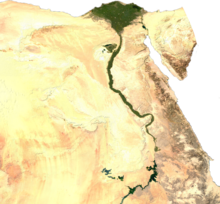
The piped water supply in Egypt increased between 1990 and 2010 from 89% to 100% in urban areas and from 39% to 93% in rural areas despite rapid population growth. Over that period, Egypt achieved the elimination of open defecation in rural areas and invested in infrastructure. Access to an improved water source in Egypt is now practically universal with a rate of 99%. About one half of the population is connected to sanitary sewers.[8]
Partly because of low sanitation coverage about 17,000 children die each year because of diarrhoea.[9] Another challenge is low cost recovery due to water tariffs that are among the lowest in the world. This in turn requires government subsidies even for operating costs, a situation that has been aggravated by salary increases without tariff increases after the Arab Spring. Poor operation of facilities, such as water and wastewater treatment plants, as well as limited government accountability and transparency, are also issues.
Due to the absence of appreciable rainfall, Egypt's agriculture depends entirely on irrigation. The main source of irrigation water is the river Nile of which the flow is controlled by the high dam at Aswan. It releases, on average, 55 cubic kilometres (45,000,000 acre·ft) water per year, of which some 46 cubic kilometres (37,000,000 acre·ft) are diverted into the irrigation canals.[10]
In the Nile valley and delta, almost 33,600 square kilometres (13,000 sq mi) of land benefit from these irrigation waters producing on average 1.8 crops per year.[10]
Demographics
[değiştir | kaynağı değiştir]
Egypt is the most populated country in the Arab world and the third most populous on the African continent, with about 95 million inhabitants (2017 itibarıyla).[11] Its population grew rapidly from 1970 to 2010 due to medical advances and increases in agricultural productivity[12] enabled by the Green Revolution.[13] Egypt's population was estimated at 3 million when Napoleon invaded the country in 1798.[14]
Egypt's people are highly urbanised, being concentrated along the Nile (notably Cairo and Alexandria), in the Delta and near the Suez Canal. Egyptians are divided demographically into those who live in the major urban centres and the fellahin, or farmers, that reside in rural villages. The total inhabited area constitutes only 77,041 km², putting the physiological density at over 1,200 people per km2, similar to Bangladesh.
While emigration was restricted under Nasser, thousands of Egyptian professionals were dispatched abroad in the context of the Arab Cold War.[15] Egyptian emigration was liberalised in 1971, under President Sadat, reaching record numbers after the 1973 oil crisis.[16] An estimated 2.7 million Egyptians live abroad. Approximately 70% of Egyptian migrants live in Arab countries (923,600 in Saudi Arabia, 332,600 in Libya, 226,850 in Jordan, 190,550 in Kuwait with the rest elsewhere in the region) and the remaining 30% reside mostly in Europe and North America (318,000 in the United States, 110,000 in Canada and 90,000 in Italy).[17] The process of emigrating to non-Arab states has been ongoing since the 1950s.[18]
Ethnic groups
[değiştir | kaynağı değiştir]Ethnic Egyptians are by far the largest ethnic group in the country, constituting 99.7% of the total population.[19] Ethnic minorities include the Abazas, Turks, Greeks, Bedouin Arab tribes living in the eastern deserts and the Sinai Peninsula, the Berber-speaking Siwis (Amazigh) of the Siwa Oasis, and the Nubian communities clustered along the Nile. There are also tribal Beja communities concentrated in the southeasternmost corner of the country, and a number of Dom clans mostly in the Nile Delta and Faiyum who are progressively becoming assimilated as urbanisation increases.
Some 5 million immigrants live in Egypt, mostly Sudanese, "some of whom have lived in Egypt for generations".[20] Smaller numbers of immigrants come from Iraq, Ethiopia, Somalia, South Sudan, and Eritrea.[20]
The Office of the United Nations High Commissioner for Refugees estimated that the total number of "people of concern" (refugees, asylum seekers, and stateless people) was about 250,000. In 2015, the number of registered Syrian refugees in Egypt was 117,000, a decrease from the previous year.[20] Egyptian government claims that a half-million Syrian refugees live in Egypt are thought to be exaggerated.[20] There are 28,000 registered Sudanese refugees in Egypt.[20]
Jewish communities in Egypt have almost disappeared. Several important Jewish archaeological and historical sites are found in Cairo, Alexandria and other cities.
Languages
[değiştir | kaynağı değiştir]The official language of the Republic is Literary Arabic.[21] The spoken languages are: Egyptian Arabic (68%), Sa'idi Arabic (29%), Eastern Egyptian Bedawi Arabic (1.6%), Sudanese Arabic (0.6%), Domari (0.3%), Nobiin (0.3%), Beja (0.1%), Siwi and others.[kaynak belirtilmeli] Additionally, Greek, Armenian and Italian, and more recently, African languages like Amharic and Tigrigna are the main languages of immigrants.
The main foreign languages taught in schools, by order of popularity, are English, French, German and Italian.
Historically Egyptian was spoken, the latest stage of which is Coptic Egyptian. Spoken Coptic was mostly extinct by the 17th century but may have survived in isolated pockets in Upper Egypt as late as the 19th century. It remains in use as the liturgical language of the Coptic Orthodox Church of Alexandria.[22][23] It forms a separate branch among the family of Afroasiatic languages.
Religion
[değiştir | kaynağı değiştir]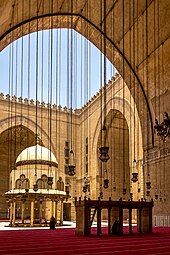
Islam is the state religion of Egypt, and the country has the largest Muslim population in the Arab world and the world's sixth largest Muslim population, accounting for five percent of all Muslims worldwide.[24] Egypt also has the largest Christian population in the Middle East and North Africa.[25] Official data about religion is lacking due to social and political sensitivities.[26] An estimated 85–90% are identified as Muslim, 10–15% as Coptic Christians, and 1% as other Christian denominations; other estimates place the Christian population as high as 15–20%.[a]
Egypt was an early and leading center of Christianity into late antiquity; the Coptic Orthodox Church of Alexandria was founded in the first century and remains the largest church in the country. With the arrival of Islam in the seventh century, the country was gradually Islamised into a majority-Muslim country.[33][34] It is unknown when Muslims reached a majority, variously estimated from y. 1000 CE to as late as the 14th century. Egypt emerged as a centre of politics and culture in the Muslim world. Under Anwar Sadat, Islam became the official state religion and Sharia the main source of law.[35]
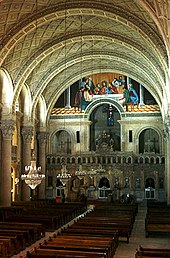
The majority of Egyptian Muslims adhere to the Sunni branch of Islam. Nondenominational Muslims form roughly 12% of the population.[32][36] There is also a Shi'a minority. The Jerusalem Center for Public Affairs estimates the Shia population at 1 to 2.2 million[37] and could measure as much as 3 million.[38] The Ahmadiyya population is estimated at less than 50,000,[39] whereas the Salafi (ultra-conservative Sunni) population is estimated at five to six million.[40] Cairo is famous for its numerous mosque minarets and has been dubbed "The City of 1,000 Minarets".[41] The city also hosts Al-Azhar University, which is considered the preeminent institution of Islamic higher learning and jurisprudence;[42] founded in the late tenth century, it is by some measures the second oldest continuously operating university in the world.[43] It is estimated that 15 million Egyptians follow native Sufi orders,[44][45] with Sufi leadership asserting that the numbers are much greater, as many Egyptian Sufis are not officially registered with a Sufi order.[44] At least 305 people were killed during a November 2017 attack on a Sufi mosque in Sinai.[46]
Of the Christian population in Egypt over 90% belong to the native Coptic Orthodox Church of Alexandria, an Oriental Orthodox Christian Church.[47] Other native Egyptian Christians are adherents of the Coptic Catholic Church, the Evangelical Church of Egypt and various other Protestant denominations. Non-native Christian communities are largely found in the urban regions of Cairo and Alexandria, such as the Syro-Lebanese, who belong to Greek Catholic, Greek Orthodox, and Maronite Catholic denominations.[48]
The Egyptian government recognises only three religions: Islam, Christianity, and Judaism. Other faiths and minority Muslim sects, such as the small Baháʼí Faith and Ahmadiyya communities, are not recognised by the state and face persecution by the government, which labels these groups a threat to Egypt's national security.[49][50] Individuals, particularly Baháʼís and atheists, wishing to include their religion (or lack thereof) on their mandatory state issued identification cards are denied this ability, and are put in the position of either not obtaining required identification or lying about their faith. A 2008 court ruling allowed members of unrecognised faiths to obtain identification and leave the religion field blank.[51][52]
Education
[değiştir | kaynağı değiştir]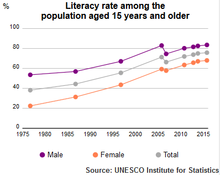
In 2022, Egypt's adult literacy rate was 74.5%, compared to 71.1% in 2017.[53] Literacy is lowest among those over 60 years of age, at 35.1%, and highest among youth between 15 and 24 years of age, at 92.2%.[54]
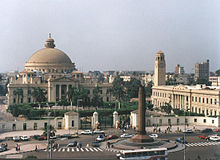
A European-style education system was first introduced in Egypt by the Ottomans in the early 19th century to nurture a class of loyal bureaucrats and army officers.[55] Under British occupation, investment in education was curbed drastically, and secular public schools, which had previously been free, began to charge fees.[55]
In the 1950s, President Nasser phased in free education for all Egyptians.[55] The Egyptian curriculum influenced other Arab education systems, which often employed Egyptian-trained teachers.[55] Demand soon outstripped the level of available state resources, causing the quality of public education to deteriorate.[55] Today this trend has culminated in poor teacher–student ratios (often around one to fifty) and persistent gender inequality.[55]
Basic education, which includes six years of primary and three years of preparatory school, is a right for Egyptian children from the age of six.[56] After grade 9, students are tracked into one of two strands of secondary education: general or technical schools. General secondary education prepares students for further education, and graduates of this track normally join higher education institutes based on the results of the Thanaweya Amma, the leaving exam.[56]
Technical secondary education has two strands, one lasting three years and a more advanced education lasting five. Graduates of these schools may have access to higher education based on their results on the final exam, but this is generally uncommon.[56]
Cairo University is Egypt's premier public university. The country is currently opening new research institutes with the aim of modernising scientific research and development; the most recent example is Zewail City of Science and Technology. Egypt was ranked 86th in the Global Innovation Index in 2023, up from 92nd in 2019.[57][58]
Health
[değiştir | kaynağı değiştir]
Egyptian life expectancy at birth was 73.20 years in 2011, or 71.30 years for males and 75.20 years for females. Egypt spends 3.7 percent of its gross domestic product on health including treatment costs 22 percent incurred by citizens and the rest by the state.[59] In 2010, spending on healthcare accounted for 4.66% of the country's GDP. In 2009, there were 16.04 physicians and 33.80 nurses per 10,000 inhabitants.[60]
As a result of modernisation efforts over the years, Egypt's healthcare system has made great strides forward. Access to healthcare in both urban and rural areas greatly improved and immunisation programmes are now able to cover 98% of the population. Life expectancy increased from 44.8 years during the 1960s to 72.12 years in 2009. There was a noticeable decline of the infant mortality rate (during the 1970s to the 1980s the infant mortality rate was 101–132/1000 live births, in 2000 the rate was 50–60/1000, and in 2008 it was 28–30/1000).[61]
According to the World Health Organization in 2008, an estimated 91.1% of Egypt's girls and women aged 15 to 49 have been subjected to genital mutilation,[62] despite being illegal in the country. In 2016 the law was amended to impose tougher penalties on those convicted of performing the procedure, pegging the highest jail term at 15 years. Those who escort victims to the procedure can also face jail terms up to 3 years.[63]
The total number of Egyptians with health insurance reached 37 million in 2009, of which 11 million are minors, providing an insurance coverage of approximately 52 percent of Egypt's population.[64]
Largest cities
[değiştir | kaynağı değiştir]Culture
[değiştir | kaynağı değiştir]Egypt is a recognised cultural trendsetter of the Arabic-speaking world. Contemporary Arabic and Middle-Eastern culture is heavily influenced by Egyptian literature, music, film and television. Egypt gained a regional leadership role during the 1950s and 1960s, giving a further enduring boost to the standing of Egyptian culture in the Arabic-speaking world.[65]
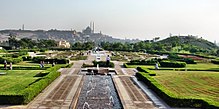
Egyptian identity evolved in the span of a long period of occupation to accommodate Islam, Christianity and Judaism; and a new language, Arabic, and its spoken descendant, Egyptian Arabic which is also based on many Ancient Egyptian words.[66]
The work of early 19th century scholar Rifa'a al-Tahtawi renewed interest in Egyptian antiquity and exposed Egyptian society to Enlightenment principles. Tahtawi co-founded with education reformer Ali Mubarak a native Egyptology school that looked for inspiration to medieval Egyptian scholars, such as Suyuti and Maqrizi, who themselves studied the history, language and antiquities of Egypt.[67]
Egypt's renaissance peaked in the late 19th and early 20th centuries through the work of people like Muhammad Abduh, Ahmed Lutfi el-Sayed, Muhammad Loutfi Goumah, Tawfiq el-Hakim, Louis Awad, Qasim Amin, Salama Moussa, Taha Hussein and Mahmoud Mokhtar. They forged a liberal path for Egypt expressed as a commitment to personal freedom, secularism and faith in science to bring progress.[68]
Arts
[değiştir | kaynağı değiştir]
The Egyptians were one of the first major civilisations to codify design elements in art and architecture. Egyptian blue, also known as calcium copper silicate, is a pigment used by Egyptians for thousands of years. It is considered to be the first synthetic pigment. The wall paintings done in the service of the Pharaohs followed a rigid code of visual rules and meanings. Egyptian civilisation is renowned for its colossal pyramids, temples and monumental tombs.
Well-known examples are the Pyramid of Djoser designed by ancient architect and engineer Imhotep, the Sphinx, and the temple of Abu Simbel. Modern and contemporary Egyptian art can be as diverse as any works in the world art scene, from the vernacular architecture of Hassan Fathy and Ramses Wissa Wassef, to Mahmoud Mokhtar's sculptures, to the distinctive Coptic iconography of Isaac Fanous. The Cairo Opera House serves as the main performing arts venue in the Egyptian capital.
Literature
[değiştir | kaynağı değiştir]
Egyptian literature traces its beginnings to ancient Egypt and is some of the earliest known literature. Indeed, the Egyptians were the first culture to develop literature as we know it today, that is, the book.[69] It is an important cultural element in the life of Egypt. Egyptian novelists and poets were among the first to experiment with modern styles of Arabic literature, and the forms they developed have been widely imitated throughout the Arab world.[70] The first modern Egyptian novel Zaynab by Muhammad Husayn Haykal was published in 1913 in the Egyptian vernacular.[71] Egyptian novelist Naguib Mahfouz was the first Arabic-language writer to win the Nobel Prize in Literature. Egyptian women writers include Nawal El Saadawi, well known for her feminist activism, and Alifa Rifaat who also writes about women and tradition.
Vernacular poetry is perhaps the most popular literary genre among Egyptians, represented by the works of Ahmed Fouad Negm (Fagumi), Salah Jaheen and Abdel Rahman el-Abnudi.[72]
Media
[değiştir | kaynağı değiştir]Egyptian media are highly influential throughout the Arab World, attributed to large audiences and increasing freedom from government control.[73][74] Freedom of the media is guaranteed in the constitution; however, many laws still restrict this right.[73][75]
Cinema
[değiştir | kaynağı değiştir]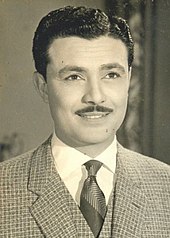

Egyptian cinema became a regional force with the coming of sound. In 1936, Studio Misr, financed by industrialist Talaat Harb, emerged as the leading Egyptian studio, a role the company retained for three decades.[76] For over 100 years, more than 4000 films have been produced in Egypt, three quarters of the total Arab production.[77][78] Egypt is considered the leading country in the field of cinema in the Arab world.[79] Actors from all over the Arab world seek to appear in the Egyptian cinema for the sake of fame. The Cairo International Film Festival has been rated as one of 11 festivals with a top class rating worldwide by the International Federation of Film Producers' Associations.[80]
The number of cinemas increased with the emergence of talking films, and reached 395 in 1958. This number began to decline after the establishment of television in 1960 and the establishment of the public sector in cinemas in 1962, and reached 297 in 1965, then to 141 in 1995 due to the circulation of films through video equipment though the boom of the film industry in this period. Due to laws and procedures that encouraged investment in the establishment of private cinemas, they increased again, especially in commercial centres, until their number reached 200 in 2001 and 400 in 2009. Over a period of more than a hundred years, Egyptian cinema has presented more than four thousand films.[81][82]
Music
[değiştir | kaynağı değiştir]
Egyptian music is a rich mixture of indigenous, Mediterranean, African and Western elements. It has been an integral part of Egyptian culture since antiquity. The ancient Egyptians credited one of their gods Hathor with the invention of music, which Osiris in turn used as part of his effort to civilise the world. Egyptians used music instruments since then.[83]
Contemporary Egyptian music traces its beginnings to the creative work of people such as Abdu al-Hamuli, Almaz and Mahmoud Osman, who influenced the later work of Sayed Darwish, Umm Kulthum, Mohammed Abdel Wahab and Abdel Halim Hafez. Prominent contemporary Egyptian pop singers include Amr Diab and Mohamed Mounir.
Dances
[değiştir | kaynağı değiştir]
Today, Egypt is often considered the home of belly dance. Egyptian belly dance has two main styles – raqs baladi and raqs sharqi. There are also numerous folkloric and character dances that may be part of an Egyptian-style belly dancer's repertoire, as well as the modern shaabi street dance which shares some elements with raqs baladi.
Museums
[değiştir | kaynağı değiştir]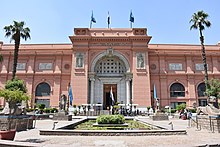
Egypt has one of the oldest civilisations in the world. It has been in contact with many other civilisations and nations and has been through so many eras, starting from prehistoric age to the modern age, passing through so many ages such as Pharonic, Roman, Greek, Islamic and many other ages. At least 60 museums may be found in Egypt.
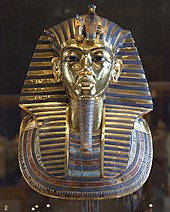
The three main museums in Egypt are The Egyptian Museum which has more than 120,000 items, the Egyptian National Military Museum and the 6th of October Panorama.
The Grand Egyptian Museum (GEM), also known as the Giza Museum, is an under construction museum that will house the largest collection of ancient Egyptian artifacts in the world, it has been described as the world's largest archaeological museum.[84] The museum was scheduled to open in 2015 and will be sited on 50 hektar (120 akre) of land approximately iki kilometre (1,2 mil) from the Giza Necropolis and is part of a new master plan for the plateau. The Minister of Antiquities Mamdouh al-Damaty announced in May 2015 that the museum will be partially opened in May 2018.[85]
Festivals
[değiştir | kaynağı değiştir]Egypt celebrates many festivals and religious carnivals, also known as mulid. They are usually associated with a particular Coptic or Sufi saint, but are often celebrated by Egyptians irrespective of creed or religion.
The ancient spring festival of Sham en Nisim (Coptic: Şablon:Coptic shom en nisim) has been celebrated by Egyptians for thousands of years, typically between the Egyptian months of Paremoude (April) and Pashons (May), following Easter Sunday.
Cuisine
[değiştir | kaynağı değiştir]
Egyptian cuisine relies heavily on legume and vegetable dishes. Although food in Alexandria and the coast of Egypt tends to use a great deal of fish and other seafood, for the most part Egyptian cuisine is based on foods that grow out of the ground. Meat has been very expensive for most Egyptians throughout history, so a great number of vegetarian dishes have been developed.
Some consider kushari (a mixture of rice, lentils, and macaroni) to be the national dish. In addition, ful medames (mashed fava beans) is one of the most popular dishes. Fava bean is also used in making falafel (also known as "ta'miya"), which may have originated in Egypt and spread to other parts of the Middle East. Garlic fried with coriander is added to molokhiya, a popular green soup made from finely chopped jute leaves, sometimes with chicken or rabbit.
Sports
[değiştir | kaynağı değiştir]
Football is the most popular national sport of Egypt. The Cairo Derby is one of the fiercest derbies in Africa, and the BBC picked it as one of the 7 toughest derbies in the world.[86] Al Ahly is the most successful club of the 20th century in the African continent according to CAF, closely followed by their rivals Zamalek SC. They are known as the "African Club of the Century". With twenty titles, Al Ahly is currently the world's most successful club in terms of international trophies, surpassing Italy's A.C. Milan and Argentina's Boca Juniors, both having eighteen.[87]
The Egyptian national football team, known as the Pharaohs, won the African Cup of Nations seven times, including three times in a row in 2006, 2008, and 2010. Considered the most successful African national team and one which has reached the top 10 of the FIFA world rankings, Egypt has qualified for the FIFA World Cup three times. Two goals from star player Mohamed Salah in their last qualifying game took Egypt through to the 2018 FIFA World Cup.[88] The Egyptian Youth National team Young Pharaohs won the Bronze Medal of the 2001 FIFA youth world cup in Argentina. Egypt was 4th place in the football tournament in the 1928 and the 1964 Olympics.
Squash and tennis are other popular sports in Egypt. The Egyptian squash team has been competitive in international championships since the 1930s. Amr Shabana, Ali Farag and Ramy Ashour are Egypt's best players and all were ranked the world's number one squash player. Egypt has won the Squash World Championships five times, with the last title being in 2019.
In 1999, Egypt hosted the IHF World Men's Handball Championship, and hosted it again in 2021. In 2001, the national handball team achieved its best result in the tournament by reaching fourth place. Egypt has won in the African Men's Handball Championship five times, being the best team in Africa. In addition to that, it also championed the Mediterranean Games in 2013, the Beach Handball World Championships in 2004 and the Summer Youth Olympics in 2010. Among all African nations, the Egypt national basketball team holds the record for best performance at the Basketball World Cup and at the Summer Olympics.[89][90] Further, the team has won a record number of 16 medals at the African Championship.
Egypt has taken part in the Summer Olympic Games since 1912 and has hosted several other international competitions including the first Mediterranean Games in 1951, the 1991 All-Africa Games, the 2009 FIFA U-20 World Cup and the 1953, 1965 and 2007 editions of the Pan Arab Games.
Egypt featured a national team in beach volleyball that competed at the 2018–2020 CAVB Beach Volleyball Continental Cup in both the women's and the men's section.[91]
See also
[değiştir | kaynağı değiştir]Notes
[değiştir | kaynağı değiştir]- ^ The population of Egypt is estimated as being 90% Muslim, 9% Coptic Christian and 1% other Christian, though estimates vary.[27][28][29] Microsoft Encarta Online similarly estimates the Sunni population at 90% of the total.[30] The Pew Forum on Religion and Public Life gave a higher estimate of the Muslim population, at 94.6%.[31] In 2017, the government-owned newspaper Al Ahram estimated the percentage of Christians at 10 to 15%.[32]
References
[değiştir | kaynağı değiştir]- ^ a b "Egypt". U.S. Energy Information Administration. 14 August 2014. 18 February 2015 tarihinde kaynağından arşivlendi. Erişim tarihi: 24 February 2015.
- ^ "Egypt to reduce natural gas exports to avoid energy crisis". AMEinfo.com. 3 August 2013 tarihinde kaynağından arşivlendi. Erişim tarihi: 6 July 2013.
- ^ "Russia to lend Egypt $25 billion to build nuclear power plant". Reuters. 19 May 2016. 16 May 2017 tarihinde kaynağından arşivlendi. Erişim tarihi: 1 July 2017.
- ^ "Egypt Says Work Finished on New Suez Canal". Voice of America. 29 July 2015. 3 August 2015 tarihinde kaynağından arşivlendi. Erişim tarihi: 24 August 2015.
- ^ "Egypt's New Suez Canal to Be Completed for Aug. 6 Ceremony". The New York Times. 30 June 2015. 16 June 2015 tarihinde kaynağından arşivlendi. Erişim tarihi: 1 August 2015.
- ^ "Egypt launches Suez Canal expansion". BBC News. 6 August 2015. 6 August 2015 tarihinde kaynağından arşivlendi. Erişim tarihi: 6 August 2015.
- ^ Tadros, Sherine (6 August 2015). "Egypt Opens New £6bn Suez Canal". Sky News. 6 August 2015 tarihinde kaynağından arşivlendi. Erişim tarihi: 6 August 2015.
- ^ As per the 2006 census
- ^ National Water Research Center, Ministry of Water Resources and Irrigation (2007): Actualizing the Right to Water: An Egyptian Perspective for an Action Plan, Shaden Abdel-Gawad. Retrieved 30 April 2012.
- ^ a b Egyptian Water Use Management Project (EWUP), 1984. Improving Egypt's Irrigation System in the Old Lands, Final Report. Colorado State University and Ministry of Public Works and Water Resources.
- ^ "Population Clock". Central Agency for Public Mobilization and Statistics. 27 April 2013. 17 January 2013 tarihinde kaynağından arşivlendi. Erişim tarihi: 27 April 2013.
- ^ "The limits of a Green Revolution?". BBC News. 29 March 2007. 28 July 2011 tarihinde kaynağından arşivlendi. Erişim tarihi: 25 August 2010.
- ^ admin (8 April 2000). "Food First/Institute for Food and Development Policy". Foodfirst.org. 14 July 2009 tarihinde kaynağından arşivlendi. Erişim tarihi: 25 August 2010.
- ^ "Egypt – Population". Countrystudies.us. 17 January 2013 tarihinde kaynağından arşivlendi. Erişim tarihi: 8 February 2013.
- ^ Tsourapas, Gerasimos (2 July 2016). "Nasser's Educators and Agitators across al-Watan al-'Arabi: Tracing the Foreign Policy Importance of Egyptian Regional Migration, 1952–1967" (PDF). British Journal of Middle Eastern Studies. 43 (3): 324–341. doi:10.1080/13530194.2015.1102708. ISSN 1353-0194. 20 July 2018 tarihinde kaynağından (PDF) arşivlendi. Erişim tarihi: 7 July 2019.
- ^ Tsourapas, Gerasimos (10 November 2015). "Why Do States Develop Multi-tier Emigrant Policies? Evidence from Egypt" (PDF). Journal of Ethnic and Migration Studies. 41 (13): 2192–2214. doi:10.1080/1369183X.2015.1049940. ISSN 1369-183X.[ölü/kırık bağlantı]
- ^ "Migration and Development in Egypt: Facts and Figures" (PDF). International Organization for Migration. 2010. 5 February 2011 tarihinde kaynağından (PDF) arşivlendi. Erişim tarihi: 21 July 2010.
- ^ Simona., Talani, Leila (1 January 2010). From Egypt to Europe : globalisation and migration across the Mediterranean. Tauris Academic Studies. OCLC 650606660.
- ^ Kaynak hatası: Geçersiz
<ref>etiketi;factbookisimli refler için metin sağlanmadı (Bkz: Kaynak gösterme) - ^ a b c d e Omer Karasapan, Who are the 5 million refugees and immigrants in Egypt? 6 Temmuz 2017[Tarih uyuşmuyor] tarihinde Wayback Machine sitesinde arşivlendi., Brookings Institution (4 October 2016).
- ^ "Constitutional Declaration 2011". Egyptian Government Services. 1 December 2017 tarihinde kaynağından arşivlendi. Erişim tarihi: 1 December 2017.
- ^ The language may have survived in isolated pockets in Upper Egypt as late as the 19th century, according to James Edward Quibell, "When did Coptic become extinct?" in Zeitschrift für ägyptische Sprache und Altertumskunde, 39 (1901), p. 87.
- ^ "Daily News Egypt – Full Article". 21 July 2011. 21 July 2011 tarihinde kaynağından arşivlendi.
- ^ "The Global Religious Landscape". Pew Research Center. December 2012. 17 January 2018 tarihinde kaynağından arşivlendi. Erişim tarihi: 5 November 2018.
- ^ Analysis (19 December 2011). "Global Christianity". Pew Research Center. 26 December 2018 tarihinde kaynağından arşivlendi. Erişim tarihi: 17 August 2012.
- ^ Hackett, Conrad (2011-02-16). "How many Christians are there in Egypt?". Pew Research Center (İngilizce). Erişim tarihi: 2024-07-07.
- ^ "Background Note: Egypt". US Department of State. 10 November 2010. 22 July 2019 tarihinde kaynağından arşivlendi. Erişim tarihi: 5 March 2011.
- ^ "Egypt". CIA. 4 September 2008. 9 October 2021 tarihinde kaynağından arşivlendi. Erişim tarihi: 15 May 2007.
- ^ "Egypt". UK Foreign and Commonwealth Office. 27 January 2008. 12 December 2012 tarihinde kaynağından arşivlendi. Erişim tarihi: 16 February 2016.
- ^ Egypt. Microsoft Encarta Online. 30 September 2008. 21 October 2009 tarihinde kaynağından arşivlendi.
- ^ "Mapping The Global Muslim Population" (PDF). Pew Forum on Religion and Public Life. s. 8. 10 October 2009 tarihinde kaynağından (PDF) arşivlendi. Erişim tarihi: 25 July 2011.
- ^ a b Alhram Online (19 November 2017). "Egypt's Sisi meets world Evangelical churches delegation in Cairo". Al Ahram. 4 May 2018 tarihinde kaynağından arşivlendi. Erişim tarihi: 26 April 2018.
- ^ "Encyclopedia Coptica: The Christian Coptic Orthodox Church Of Egypt". www.coptic.net. 31 August 2005 tarihinde kaynağından arşivlendi. Erişim tarihi: 6 January 2016.
- ^ Butler, Alfred J. (1978). The Arab Conquest of Egypt. Oxford University Press. ISBN 978-0-19-821678-0.
- ^ "Egypt". Berkley Center for Religion, Peace, and World Affairs. 20 December 2011 tarihinde kaynağından arşivlendi. Erişim tarihi: 14 December 2011.
- ^ Chapter 1: Religious Affiliation 26 Aralık 2016[Tarih uyuşmuyor] tarihinde Wayback Machine sitesinde arşivlendi. retrieved 4 September 2013
- ^ Col. (ret.) Jacques Neriah (23 September 2012). "Egypt's Shiite Minority: Between the Egyptian Hammer and the Iranian Anvil". Jerusalem Center for Public Affairs. 9 September 2013 tarihinde kaynağından arşivlendi. Erişim tarihi: 6 July 2013.
- ^ Tim Marshall (25 June 2013). "Egypt: Attack On Shia Comes At Dangerous Time". Sky News. 30 June 2013 tarihinde kaynağından arşivlendi. Erişim tarihi: 6 July 2013.
- ^ Mohammad Hassan Khalil (2013). Between Heaven and Hell: Islam, Salvation, and the Fate of Others. Oxford University Press. s. 297. ISBN 978-0-19-994541-2.
- ^ Venetia Rainey (20 April 2011). "What is Salafism and should we be worried?". Theweek.co.uk. 11 July 2013 tarihinde kaynağından arşivlendi. Erişim tarihi: 6 July 2013.
- ^ Robin Barton (19 February 2001). "Cairo: Welcome to the city of 1,000 minarets". The Independent. London. 25 September 2015 tarihinde kaynağından arşivlendi. Erişim tarihi: 26 August 2017.
- ^ "Egypt - Arabic, Coptic, Nubian | Britannica". www.britannica.com (İngilizce). 2024-07-06. Erişim tarihi: 2024-07-07.
- ^ Indira Falk Gesink, Islamic Reform and Conservatism: Al-Azhar and the Evolution of Modern Sunni Islam (I.B.Tauris, 2014), p. 2.
- ^ a b Hassan Ammar (14 June 2013). "Sufis In Egypt Thrive With More Than 15 Million Despite Attacks By Islamist Hardliners". Huffington Post. 8 July 2013 tarihinde kaynağından arşivlendi. Erişim tarihi: 6 July 2013.
- ^ Hoffman, Valerie J. (1995). Sufism, Mystics, and Saints in Modern Egypt. University of South Carolina Press.
- ^ Walsh, Declan, and Youssef, Nour, Militants Kill 305 at Sufi Mosque in Egypt's Deadliest Terrorist Attack 26 Kasım 2017[Tarih uyuşmuyor] tarihinde Wayback Machine sitesinde arşivlendi., The New York Times, 24 November 2017
- ^ Who are the Christians in the Middle East?. Betty Jane Bailey. 2009. ISBN 978-0-8028-1020-5.
- ^ "Catholics in Egypt Reflect Church's Rich and Varied Traditions". L'Osservatore Romano. 1 March 2000. ss. 6–7. 25 January 2014 tarihinde kaynağından arşivlendi. Erişim tarihi: 23 May 2013.
- ^ al-Shahat, Abdel Moneim (18 February 2012). "Shahat: Baha'is threaten Egypt's national security". Egypt Independent. 20 February 2012 tarihinde kaynağından arşivlendi. Erişim tarihi: 25 February 2012.
- ^ "Egypt Ahmadis detained under emergency law: rights group". 14 May 2010. 6 June 2014 tarihinde kaynağından arşivlendi. Erişim tarihi: 4 June 2014.
- ^ Kaynak hatası: Geçersiz
<ref>etiketi;International Religious Freedom Report 2008isimli refler için metin sağlanmadı (Bkz: Kaynak gösterme) - ^ Kaynak hatası: Geçersiz
<ref>etiketi;reutersisimli refler için metin sağlanmadı (Bkz: Kaynak gösterme) - ^ "Egypt - Literacy rate 2022". Statista (İngilizce). Erişim tarihi: 2024-07-07.
- ^ "Egypt: youth literacy rate". Statista (İngilizce). Erişim tarihi: 2024-07-07.
- ^ a b c d e f "Education in Egypt: Key Challenges" (PDF). Chatham House. March 2012. 24 December 2012 tarihinde kaynağından (PDF) arşivlendi.
- ^ a b c Higher education in Egypt (2010 bas.). OECD. 2010. s. 60. ISBN 978-92-64-08434-6. 25 January 2014 tarihinde kaynağından arşivlendi. Erişim tarihi: 16 February 2013.
- ^ WIPO (30 October 2023). Global Innovation Index 2023, 15th Edition. www.wipo.int (İngilizce). World Intellectual Property Organization. doi:10.34667/tind.46596. ISBN 9789280534320. 22 October 2023 tarihinde kaynağından arşivlendi. Erişim tarihi: 2023-10-29.
- ^ "EGYPT" (PDF). World Intellectual Property Organization. United Nations. 2020. 25 November 2023 tarihinde kaynağından (PDF) arşivlendi. Erişim tarihi: 24 January 2022.
- ^ "Demography". SESRIC. 22 June 2013 tarihinde kaynağından arşivlendi. Erişim tarihi: 8 February 2013.
- ^ "Health". SESRIC. 22 June 2013 tarihinde kaynağından arşivlendi. Erişim tarihi: 8 February 2013.
- ^ "Egypt Health Insurance". globalsurance.com. 5 September 2015 tarihinde kaynağından arşivlendi. Erişim tarihi: 25 August 2015.
- ^ "Female genital mutilation and other harmful practices". WHO. 2011. 23 April 2011 tarihinde kaynağından arşivlendi. Erişim tarihi: 28 January 2011.
- ^ "Egypt's parliament passes bill designating FGM a felony, imposes stricter penalties". Ahram Online. 2 December 2016 tarihinde kaynağından arşivlendi. Erişim tarihi: 1 December 2016.
- ^ "SIS". State Information Service. 13 November 2013 tarihinde kaynağından arşivlendi. Erişim tarihi: 28 November 2013.
- ^ "Mideast: Egypt Makes Cultural Clout Count (IPS, Oct. 29, 2009)". Ipsnews.net. 29 October 2009. 27 April 2011 tarihinde kaynağından arşivlendi. Erişim tarihi: 25 August 2010.
- ^ Raymon Kondos (15 February 2004). "The Egyptian Identity: Pharaohs, Moslems, Arabs, Africans, Middle Easterners or Mediterranean People?". 29 August 2008 tarihinde kaynağından arşivlendi. Erişim tarihi: 21 August 2008.
- ^ El-Daly, Okasha (2005). Egyptology: The Missing Millennium. London: UCL Press. s. 29.
- ^ Jankowski, James. Egypt, A Short History. s. 130.
- ^ Edwards, Amelia, The Literature and Religion of Ancient Egypt, 20 October 2007 tarihinde kaynağından arşivlendi, erişim tarihi: 30 September 2007
- ^ "Global influence of Egyptian culture". Egypt State Information Service. 4 February 2006. 24 November 2007 tarihinde kaynağından arşivlendi. Erişim tarihi: 21 August 2008.
- ^ Vatikiotis, P.J. (1991). The history of modern Egypt: from Muhammad Ali to Mubarak (4 bas.). London: Weidenfeld and Nicolson. s. 486. ISBN 978-0-297-82034-5.
- ^ "Culture of Egypt". www.chinadaily.com.cn. Erişim tarihi: 2022-05-09.
- ^ a b "Country profiles: Egypt". BBC News. 15 January 2013. 21 April 2009 tarihinde kaynağından arşivlendi. Erişim tarihi: 8 February 2013.
- ^ "Plus ca Change: The Role of the Media in Egypt's First Contested Presidential Elections". Tbsjournal.com. 16 August 2006 tarihinde kaynağından arşivlendi. Erişim tarihi: 8 February 2013.
- ^ "Freedom House 2007 report". Freedomhouse.org. 10 May 2004. 27 December 2010 tarihinde kaynağından arşivlendi. Erişim tarihi: 25 August 2010.
- ^ Darwish, Mustafa (1998). Dream Makers on the Nile: A Portrait of Egyptian Cinema. Cairo: American University in Cairo Press. ss. 12–13.
- ^ Houissa, Ali. "LibGuides: Middle Eastern & North African Cinema & Film: Egyptian Cinema & Film". guides.library.cornell.edu (İngilizce). Erişim tarihi: 4 October 2021.
- ^ Dajani, Karen Finlon (1 May 1980). "Cairo: the Hollywood of the Arab World". Gazette (Leiden, Netherlands) (İngilizce). 26 (2): 89–98. doi:10.1177/001654928002600202. ISSN 0016-5492.
- ^ "The golden age of Egyptian cinema - Focus". Ahram Online. Erişim tarihi: 4 February 2022.
- ^ "Cairo International Film Festival information". UKHotMovies. 1 December 2005. 5 January 2020 tarihinde kaynağından arşivlendi. Erişim tarihi: 17 February 2018.
- ^ سعد, عبدالمنعم (1976). موجز تاريخ السينما المصرية (Arapça). مطابع الأهرام التجارية.
- ^ Shafik, Viola (2007). Popular Egyptian Cinema: Gender, Class, and Nation (İngilizce). Oxford University Press. ISBN 978-977-416-053-0.
- ^ Music of Ancient Egypt 13 Ekim 2015[Tarih uyuşmuyor] tarihinde Wayback Machine sitesinde arşivlendi., Kelsey Museum of Archaeology, University of Michigan.
- ^ Nancy Farghalli (25 July 2006). "Marketplace: Egypt's next big thing". Marketplace. American Public Media. 15 May 2008 tarihinde kaynağından arşivlendi. Erişim tarihi: 31 May 2011.
- ^ "Great Museum to be inaugurated in May 2018 – Egypt Independent". 10 May 2015. 9 July 2015 tarihinde kaynağından arşivlendi. Erişim tarihi: 14 December 2016.
- ^ "BBC Sport Academy | Al-Ahly v Zamalek". BBC News. 5 August 2002. 11 May 2011 tarihinde kaynağından arşivlendi. Erişim tarihi: 25 August 2010.
- ^ "Al-Ahly – master of the world". Daily News Egypt. 11 December 2014. 11 December 2014 tarihinde kaynağından arşivlendi. Erişim tarihi: 22 December 2014.
- ^ "Mo Salah's late penalty gives Egypt first World Cup qualification since 1990". The Guardian. 8 October 2017. 6 December 2017 tarihinde kaynağından arşivlendi. Erişim tarihi: 22 March 2018.
- ^ "1950 World Championship for Men". FIBA. 9 June 2012. 13 November 2012 tarihinde kaynağından arşivlendi. Erişim tarihi: 9 June 2012.
- ^ "Egypt – 1952 Olympic Games; Tournament for Men". FIBA. 9 June 2012. 11 August 2012 tarihinde kaynağından arşivlendi. Erişim tarihi: 9 June 2012.
- ^ "Continental Cup Finals start in Africa". FIVB. 22 June 2021. Erişim tarihi: 7 August 2021.
